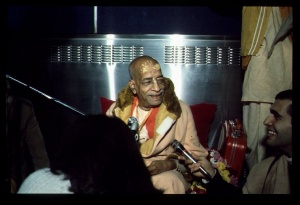CC Madhya 24.313 (1975)

A.C. Bhaktivedanta Swami Prabhupada
Below is the 1996 edition text, ready to be substituted with the 1975 one using the compile form.
TEXT 313
- ahaṁ vedmi śuko vetti
- vyāso vetti na vetti vā
- bhaktyā bhāgavataṁ grāhyaṁ
- na buddhyā na ca ṭīkayā
SYNONYMS
aham—I (Lord Śiva); vedmi—know; śukaḥ—Śukadeva Gosvāmī; vetti—knows; vyāsaḥ—Vyāsadeva; vetti—knows; na vetti vā—or may not know; bhaktyā—by devotional service (executed in nine different processes); bhāgavatam—the Bhāgavata Purāṇa (called the Paramahaṁsa-saṁhitā, the text or treatise readable by the topmost transcendentalists); grāhyam—to be accepted; na—not; buddhyā—by so-called intelligence or experimental knowledge; na—nor; ca—also; ṭīkayā—by imaginary commentary.
TRANSLATION
“[Lord Śiva said:] ‘I may know; Śukadeva Gosvāmī, the son of Vyāsadeva, may know; and Vyāsadeva may know or may not know Śrīmad-Bhāgavatam. On the whole, Śrīmad-Bhāgavatam, the spotless Purāṇa, can be learned only through devotional service, not by material intelligence, speculative methods or imaginary commentaries.’”
PURPORT
Devotional service includes nine processes, beginning with hearing, chanting and remembering the activities of Lord Viṣṇu. Only one who has taken to devotional service can understand Śrīmad-Bhāgavatam, which is the spotless Purāṇa for a transcendentalist (paramahaṁsa). So-called commentaries are useless for this purpose. According to the Vedic injunction, yasya deve parā bhaktir yathā deve tathā gurau [ŚU 6.23]. All Vedic literatures maintain that Śrīmad-Bhāgavatam has to be learned from the person bhāgavata, and to understand it one has to engage in pure devotional service. Śrīmad-Bhāgavatam cannot be understood by so-called erudite scholars or grammarians. One who has developed pure Kṛṣṇa consciousness and has served the pure devotee, the spiritual master, can understand Śrīmad-Bhāgavatam. Others cannot.